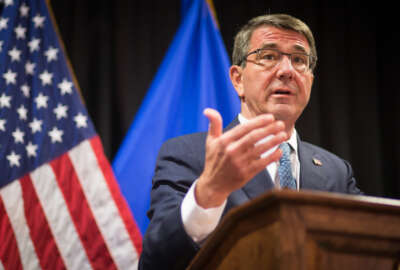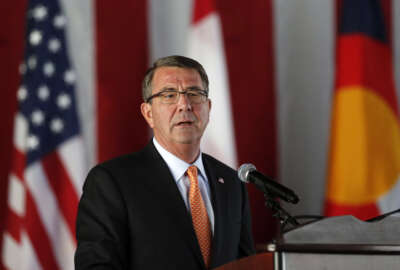
Carter’s defense innovation program gets new site, new structure, new blood
Secretary of Defense Ash Carter's defense innovation hub continues to live up to its concept, iterating and improving rapidly as it becomes bi-coastal.
The Defense Department’s innovation hub continues to live up to its concept, iterating and improving rapidly as it officially becomes bi-coastal.
Defense Secretary Ash Carter announced the opening of the new Boston office of the Defense Innovation Unit-Experimental (DIUx) during a press conference July 26. He also revealed its new organizational structure, and name-dropped a who’s who of technological, scientific and industrial innovation when he announced nine more members of the Defense Innovation Advisory Board.
DIUx was created last August as a means for DoD to partner with tech industries and harvest forward thinking ideas, located in Silicon Valley in order to give DoD proximity to one of the primary centers for technological innovation.
The new office in Boston checks off another location (still on the list: Austin, Seattle and San Francisco) and puts DoD closer to innovation centers for biosciences, engineering and data, three new priorities for DIUx.
“In addition to being a hub of East Coast economic growth, Boston is a beehive of activity for biotechnology and the biosciences. I think in decades to come, we’ll look back and view the IT revolution as having been the recent past, with the present and future being a revolution in biosciences,” Carter said.
Carter announced that Bernadette Johnson, chief technology officer at Massachusetts Institute of Technology’s Lincoln Labs, would be taking the position of DIUx’s chief science officer. Air Force Reserve Colonel Mike McGinley, a lawyer specializing in cybersecurity and leader of Cyber Command’s private-sector partnership team, is becoming active duty and will be military lead in Boston.
Carter said another senior partner would be named later this year.
DIUx has evolved rapidly since its inception, changing leadership and reorganizing just eight months after it began. Now it has evolved again under the leadership of Raj Shah, F-16 pilot and co-founder of Morta Security, pioneering a new organizational system for interfacing with both industry and the military.
“Innovative technologies and people are necessary, but not sufficient, which is why we’re also investing in innovative practices and organizational structures,” Carter said.
DIUx is now divided into three teams: Engagement, Foundry and Venture.
The Engagement Team acts as a liaison between the military and business owners, introducing private industry innovators to the problems faced by the military.
The Foundry team develops existing technologies until they can be put into use by the military. One of the ways they’re accomplishing this is with their new Warfighter-in-Residence and Entrepreneur-in-Residence programs. These programs couple soldiers with industry engineers to rapidly design, prototype and test new equipment and systems.
They’re currently working with virtual and augmented realities, Carter said, with plans to move into “new applications for commercial space technologies, advanced aerial robotics and autonomous vehicles.”
The third is the Venture team. They birddog new commercial technologies and attempt to adapt them to defense applications. They make research and development awards to companies ranging from start-ups to major tech companies. They also seek to match these projects with DoD customers for funding and staffing resources.
“It’s no longer just a matter of what we buy. Now more than ever, what also matters is how we buy things, how quickly we buy them, whom we buy them from, and how quickly and creatively we can adapt and use them in different and innovative ways — all this to stay ahead of future threats,” Carter said.
Carter listed the modernization of Russia and China’s militaries, the dissemination of technologies to “less-capable forces and non-state actors,” and the potential vulnerabilities posed by reliance on satellites and the internet.
“So to stay ahead of all these challenges, and stay the best, I’ve been pushing the Pentagon to think outside our five-sided box, and invest aggressively in innovation of all kinds — technological, organizational, operational, and in the talent management of our all-volunteer force,” he said.
Helping him to do this is the Defense Innovation Advisory Board, a group of leaders in scientific, technological and industrial innovation tasked with fostering and nurturing a sense culture of innovation within the DoD.
Previously, Carter announced that the board would be led by Chairman Eric Schmidt, executive chairman of Alphabet Inc, and would also include LinkedIn Executive Chairman Reid Hoffman, U.S. Special Operations commander Bill McRaven and the Aspen Institute’s Walter Isaacson.
Carter added nine new names to that list, including Amazon CEO and Chairman Jeff Bezos, astrophysicist and author Neil deGrasse Tyson, and Code for America Founder Jennifer Pahlka, among others.
“At the outset, I’ve given them the very specific task of identifying innovative private sector best practices that could be of use to DoD — not unlike our recent Hack the Pentagon pilot program, which invited hackers to help find vulnerabilities in our networks, similar to the bug bounties that several of America’s leading tech companies have,” Carter said. “It’s a perfect example of the kind of thing I’m looking for the Innovation Board to recommend.”
Carter said the DIAB would recommend its first wave of practices by fall, although he cautioned that not all of them would make sense to implement, as the military differs in many significant ways from companies.
“But that doesn’t mean we can’t look ourselves in the mirror, and look around the country for new ideas, for lessons we can learn, and for ways we can operate more effectively,” he said.
Copyright © 2025 Federal News Network. All rights reserved. This website is not intended for users located within the European Economic Area.
Daisy Thornton is Federal News Network’s digital managing editor. In addition to her editing responsibilities, she covers federal management, workforce and technology issues. She is also the commentary editor; email her your letters to the editor and pitches for contributed bylines.
Follow @dthorntonWFED





